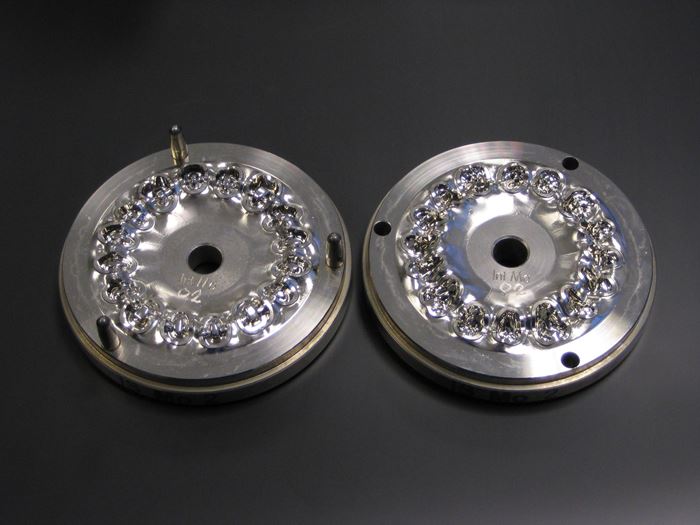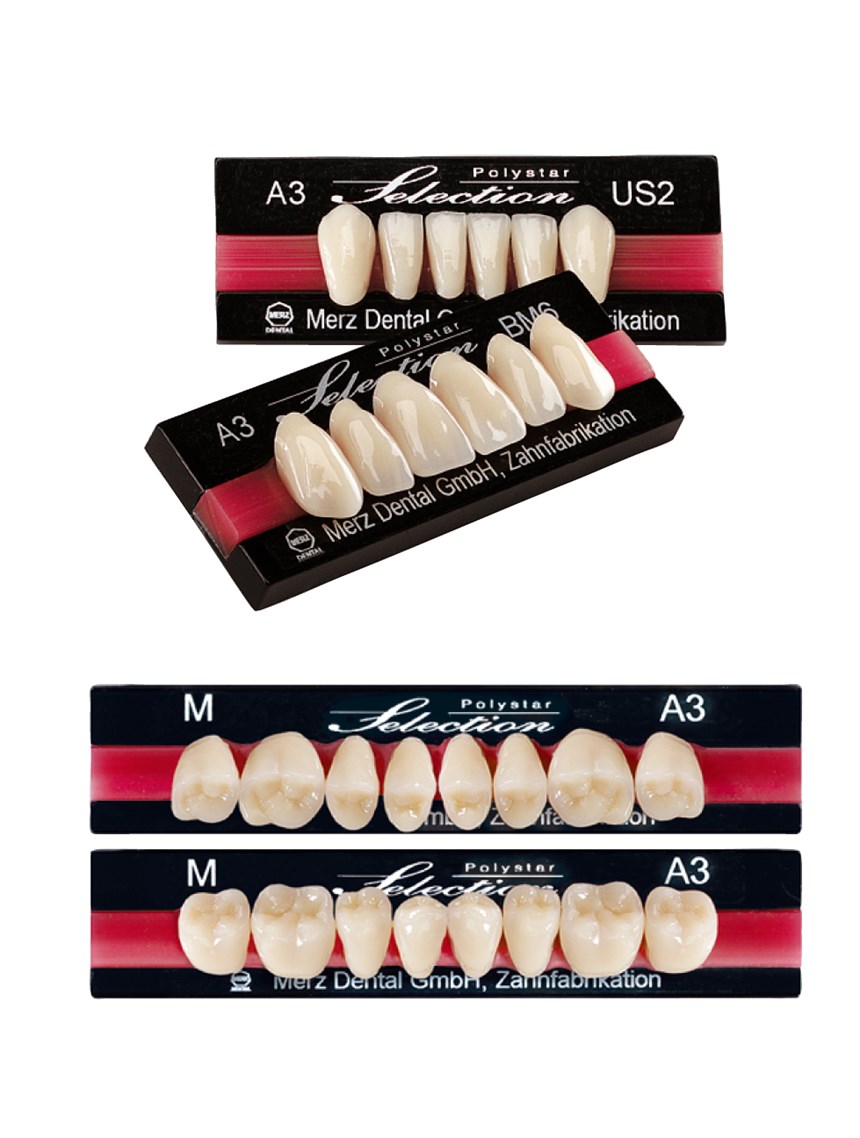Dental Mold Challenges Are Overcome with the Right 3-D Design-for-Manufacturing Solution
An organic 3-D design-for-manufacturing solution from SensAble Technologies allowed Merz Dental to reduce the process of designing and producing a finished mold for a family of denture teeth from 24 months, to just 6 months, while increasing quality.
Denture teeth follow fashion trends, just like clothes—so when natural teeth need to be replaced, dentists and their patients can choose from denture (artificial) tooth styles that range from utilitarian to couture. Merz Dental GmbH of Lütjenburg, Germany is one of the high-end designers in the denture tooth business, with manufacturing capacity to make more than 15 million artificial teeth each year.
Merz Dental denture teeth have the gentle curves, varying thicknesses, natural ridges and other surface details that imitate nature perfectly—shapes that depend on seemingly small but pivotal design differences, and that are typically updated every few years. In addition, because denture teeth must be positioned carefully to provide the proper alignment for either a full or partial set of dentures, both design accuracy and manufacturing precision are vital. Therefore the molds (Figure 1) used to manufacture denture teeth in polymethylmethacrylate (PMMA) or similar acrylics must be no less than perfect to assure an end product that is functional and comfortable for eating and speaking, and also aesthetically pleasing.
Merz Dental prides itself on being the first denture tooth manufacturer to use CAD/CAM for artificial tooth design. The company spent an entire year testing various CAD/CAM solutions and implemented FreeForm, an organic 3-D design-for-manufacturing solution from SensAble Technologies, in 2003 to support a faster workflow.
FreeForm allowed Merz Dental to reduce the process of designing and producing a finished mold for a family of denture teeth from 24 months, to just 6 months, while increasing quality. With both its organic 3-D design capabilities and its features for analyzing 3-D models, FreeForm has helped Merz Dental to expedite the process of assuring a quality mold for volume manufacture. With each successive FreeForm software update, Merz Dental reports additional time savings and total digital workflow refinement.
Since 1952 when it did business under the name of Zahnfabrik Werchan Dental GmbH, and prior to its merger with the dental materials unit of Merz Pharma GmbH & Co., Merz Dental has continually updated its denture tooth product lines and redesigns one of its tooth families every several years.
Its four tooth families vary by such aesthetics as shape (round, square or flat), size, and color—with each family available in up to 22 sizes. Furthermore, each denture tooth family includes each of the 32 human teeth that can be purchased either as a total set (see Figure 2 showing a full set of denture teeth on a card)) or individually. Such extensive product sizing options mean that Merz Dental must maintain more than 280 molds for tooth manufacture—making the business intensely mold-centered.
Traditional Workflow Challenges
The traditional denture tooth workflow involved manually shaping proposed designs in wax, then making molds using an electronic etching process, also manually performed—an art that many had perfected, but that wasn’t precise and was very time-consuming. While the advent of CAD/CAM vastly improved the design and moldmaking process by providing a digital starting point for model refinement and more accurate and precise machining, traditional CAD/CAM tools and workflows also presented some obstacles and challenges:
1. A traditional CAD workflow moves from scanning to surfacing to reshaping the NURBS surfaces. The process is fine for highly geometric designs, but with organic shapes such as denture teeth, standard CAD-systems are unable to manipulate the reversed patches smoothly—requiring more time and generally producing less favorable results.
2. The traditional moldmaking process has been entirely dependent on NURBS surfaces for machining, but NURBS are not the best definition format for capturing the complex shapes of the tooth.
3. Most moldmakers are very skeptical about milling directly from an STL file. In traditional CAD/CAM systems, it's almost impossible to split the STL or to find a parting line on the STL. Yet machining on well-prepared STLs, combined with perfect parting surfaces and boundaries, is faster and leads to better results.
An Improved CAD/CAM Workflow
But, the right CAD/CAM workflow can eliminate weeks from the modeling and moldmaking process while assuring precision and accuracy. Enter FreeForm—which allows Merz Dental to avoid patches and NURBs, and to mill off the STL file. Merz Dental's mold department has fully integrated SensAble’s FreeForm into its design and manufacturing processes. To expedite the workflow, Merz Dental relied on local CAD/CAM consultant Antonius Koester GmbH, who also has extensive knowledge of high-speed milling and scanning.
At Merz Dental, designers start by importing 3-D scans of existing denture teeth or tooth library files (typically STL files) into FreeForm for quick clean up and modification—optimizing shape and scaling teeth to varying sizes. Traditional CAD modelers would be almost impossible to use to create these organic shapes, but FreeForm is a 3-D organic design-for-manufacturing system that is based on voxels—think of voxels as 3-D pixels—allowing designers to sculpt with digital clay in a manner similar to physical clay. FreeForm’s voxel-based modeling provides unrivaled speed in achieving a precise shape-match to a natural tooth. In addition, with FreeForm there is no need for managing the complex patch plan and patch-to-patch relationships—as would be required in surface or solid modelers—to change the tooth’s shape.
Christian Borowski, master moldmaker at Merz Dental, relates that FreeForm’s unique use of a haptic (touch-enabled) device, instead of a computer mouse, allows a high degree of design refinement that is key to Merz Dental’s market positioning for providing exceptionally aesthetic artificial teeth. SensAble’s haptic device allows users to model with a stylus that literally pushes back on the user’s hand so that the Merz Dental team members can feel the evolving denture tooth model as they are designing on screen. This sculptural accuracy saves time and is enormously beneficial. Users simply sculpt, tug and carve away at the design on screen, allowing them to model a more natural looking design in a fraction of the time it would take to complete manually.
Next Christian and his team analyze the tooth designs for manufacturability in FreeForm, fixing undercuts and using FreeForm’s specialized tools to identify the best parting direction and optimize the parting line curve so it allows for a better quality mold design downstream. According to Christian, with FreeForm designing for optimal removal of the finished tooth from the mold is really fast, precise and easy. A relatively recent addition of FreeForm’s Split Mesh feature allows molds to be designed as a mixture of STL files (for capturing the tooth form) and NURBS (for defining the shutout surfaces). STL-defined mold cavities allow Merz Dental to retain more texture on the tooth, which allows Merz Dental to mill directly from the STL file without losing the important details and texture of the teeth—critical for a realistic look. When designs are ready for review, Merz Dental makes prototype molds to test the design, then mills using STL files on a Roeders high-speed milling machine to create the final molds used in the finished manufacturing of its teeth. Merz Dental also offers these special design services to other companies.
Summary
“FreeForm allows us incredible precision that isn’t possible by hand—and speed that isn’t possible with other CAD/CAM solutions,” says Christian Borowski at Merz Dental. “The solution has helped us assure exceptional 3-D models and precision molds up front, when changes are fast and easy to make—and streamline our entire mold-driven manufacturing process.”
Related Content
The In's and Out's of Ballbar Calibration
This machine tool diagnostic device allows the detection of errors noticeable only while machine tools are in motion.
Read MoreHow to Manage Wall Thickness Changes in Your Mold Design
To ensure even filling and cooling, consider wall section transitions, corners and fillets, ribs and bosses, lip and rim designs and CAE flow simulation software.
Read MoreCAM Automation Increases Mold Production, Quality
Mold builder switches CAM software package after 20 years to take advantage of innovative programming strategies that reduce mold machining programming and processing times.
Read MoreMoldMaking Technology's Most-Viewed Content 2022: Products
MMT shares the five top-viewed technologies, equipment and services of 2022 in each Engineer, Build, Maintain and Manage tenet based on Google Analytics.
Read MoreRead Next
How to Use Continuing Education to Remain Competitive in Moldmaking
Continued training helps moldmakers make tooling decisions and properly use the latest cutting tool to efficiently machine high-quality molds.
Read MoreHow to Use Strategic Planning Tools, Data to Manage the Human Side of Business
Q&A with Marion Wells, MMT EAB member and founder of Human Asset Management.
Read MoreAre You a Moldmaker Considering 3D Printing? Consider the 3D Printing Workshop at NPE2024
Presentations will cover 3D printing for mold tooling, material innovation, product development, bridge production and full-scale, high-volume additive manufacturing.
Read More





.jpg;maxWidth=300;quality=90)








_300x250 1.png;maxWidth=300;quality=90)












